DominionSections
Browse Articles
- IndependentMedia.ca
- MostlyWater.org
- Seven Oaks
- BASICS Newsletter
- Siafu
- Briarpatch Magazine
- The Leveller
- Groundwire
- Redwire Magazine
- Canadian Dimension
- CKDU News Collective
- Common Ground
- Shunpiking Magazine
- The Real News
- Our Times
- À babord !
- Blackfly Magazine
- Guerilla News Network
- The Other Side
- The Sunday Independent
- Vive le Canada
- Elements
- ACTivist Magazine
- The Tyee
- TML Daily
- New Socialist
- Relay (Socialist Project)
- Socialist Worker
- Socialist Action
- Rabble.ca
- Straight Goods
- Alternatives Journal
- This Magazine
- Dialogue Magazine
- Orato
- Rebel Youth
- NB Media Co-op
Radio
Guatemalan Women Speak Out Against Rape
August 23, 2010
Guatemalan Women Speak Out Against Rape
Soldiers, police, security terrorized residents who live in nickel-rich area
 Elders weep during a ceremony held last spring, after women from the community testified that they were gang raped in January 2007. Photo: Nathan Einbinder
Elders weep during a ceremony held last spring, after women from the community testified that they were gang raped in January 2007. Photo: Nathan Einbinder

EL ESTOR, GUATEMALA—It was the middle of May, just days into the rainy season, when I made the trip to Lote 8, one of the dozens of Maya-Qeqchi villages scattered about the steep and perennially green Santa Cruz mountain range in eastern Guatemala. Clouds formed and dissipated over the Western Highlands, reaching by dusk the lowlands around Lake Izabal and the Polochic River basin. Then the stagnant heat broke, in storm. In the weeks to come, the rains would increase, scouring the mountains of their red-tinted earth, forcing it to the valley below, and eventually out to sea.
Roughly 100 years ago, the Maya-Qeqchi of Izabal began to occupy the marginal lands. Many still live on these lands—on the narrow sloping tracts beneath the mountain, within view of the sprawling lake and the distant mist-shrouded ridges of the Sierra de las Minas to the south. Others, like those from Lote 8, fled the lowlands below, higher into the mountains. Despite the steep slopes and rugged terrain, they took root, grew with family, endured flood and drought, had plentiful harvests and practiced the ancient ways.
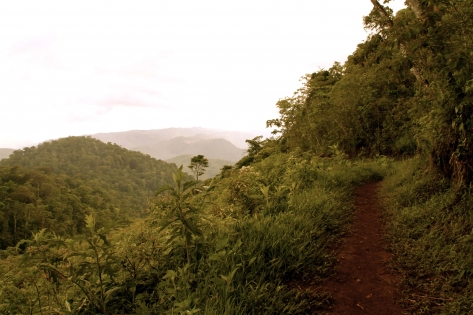 Not unlike numerous other Indigenous communities in the region, the initial departure of Lote 8 residents from the rich plain below—the lands of their original milpa (subsistence plots of corn, beans and squash)—occurred long ago, a result of expansion of the US-controlled banana empire. Today it is hard to believe that these lowlands, seemingly empty and desolate save for cattle, were once the historic lands of the United Fruit Company. In the 1920s, the lands would have had rows of short banana palms stretching as far as the eye could see. Indigenous peoples lived precariously in the corners, harvesting and cleaning the spaces between the trees. By national decree Indigenous men worked the fields and bought from company stores. Those who raised their voices in dissent were quickly silenced.
Not unlike numerous other Indigenous communities in the region, the initial departure of Lote 8 residents from the rich plain below—the lands of their original milpa (subsistence plots of corn, beans and squash)—occurred long ago, a result of expansion of the US-controlled banana empire. Today it is hard to believe that these lowlands, seemingly empty and desolate save for cattle, were once the historic lands of the United Fruit Company. In the 1920s, the lands would have had rows of short banana palms stretching as far as the eye could see. Indigenous peoples lived precariously in the corners, harvesting and cleaning the spaces between the trees. By national decree Indigenous men worked the fields and bought from company stores. Those who raised their voices in dissent were quickly silenced.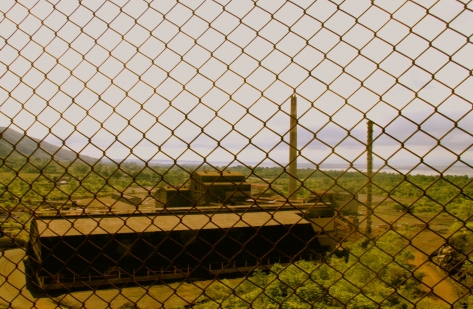 But the earth was red, and others, from the North, knew that this meant mineral wealth: materials that could be extracted, processed and sold in a global market. And so it was that in the time of rapid "development" in the 60s, 70s and 80s (and, not by coincidence, during the period of civil unrest and armed insurrection), when the World Bank sold a prescription of “poverty elimination” to Third World countries like Guatemala, and when it was decided by those in Guatemala City, in Toronto and in Washington, DC, that this land was better off in the hands of foreigners, and the subsurface should be under their jurisdiction. During the internal conflict, the processing plant pictured here was built on the lake’s edge. The town of El Estor, a prominent (though dying) outpost from the United Fruit heyday, served as the mine's base. The surrounding lands were signed over by Guatemalan army generals, all 350-plus square kilometres of it, where the best ore presumably lay beneath the tropical woods, rivers and cornfields. The span of the mine's operation was short, and tumultuous and deadly for those who lived by the land. The ownership of the mine's concession and infrastructure passed through numerous hands, through mergers and acquisitions, in order to retain licenses that the original company, Canadian-owned EXMIBAL, a subsidiary of INCO (The Canadian International Nickel Company) purchased in 1965. As of the past thirty years, since its indefinite closure, the mine site remains empty and rusting in the wet wind. But as everyone knows, vast reserves of nickel ore are still scattered throughout the site. And as long as the possibility for reopening exists, as it does today more than ever before, those who live within the concession must, and will, be removed.
But the earth was red, and others, from the North, knew that this meant mineral wealth: materials that could be extracted, processed and sold in a global market. And so it was that in the time of rapid "development" in the 60s, 70s and 80s (and, not by coincidence, during the period of civil unrest and armed insurrection), when the World Bank sold a prescription of “poverty elimination” to Third World countries like Guatemala, and when it was decided by those in Guatemala City, in Toronto and in Washington, DC, that this land was better off in the hands of foreigners, and the subsurface should be under their jurisdiction. During the internal conflict, the processing plant pictured here was built on the lake’s edge. The town of El Estor, a prominent (though dying) outpost from the United Fruit heyday, served as the mine's base. The surrounding lands were signed over by Guatemalan army generals, all 350-plus square kilometres of it, where the best ore presumably lay beneath the tropical woods, rivers and cornfields. The span of the mine's operation was short, and tumultuous and deadly for those who lived by the land. The ownership of the mine's concession and infrastructure passed through numerous hands, through mergers and acquisitions, in order to retain licenses that the original company, Canadian-owned EXMIBAL, a subsidiary of INCO (The Canadian International Nickel Company) purchased in 1965. As of the past thirty years, since its indefinite closure, the mine site remains empty and rusting in the wet wind. But as everyone knows, vast reserves of nickel ore are still scattered throughout the site. And as long as the possibility for reopening exists, as it does today more than ever before, those who live within the concession must, and will, be removed.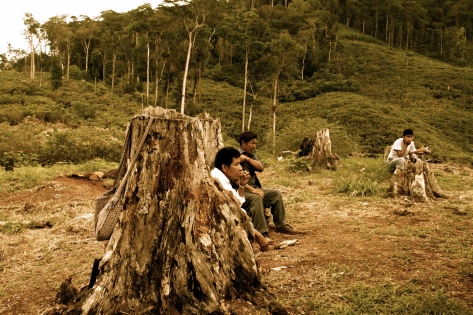 Riding in the back of a pickup truck, our delegation climbed the rough pathways above the lake and river basin, beyond other settlements where farmers were occupying land flat enough to erect thatched-hut dwellings and to plant their corn. Ever since INCO sold the mine to Skye Resources in 2004 and the potential for mining began again in earnest, the company and the Guatemalan government have cleared out individuals and communities living within the concession: the Maya-Qeqchi farmers, living on the land of their birth, the land of their ancestors. Burned, shot at, intimidated, chased deeper; the tactics were brutal, deceitful; and justice is a word that brings laughter to most in this country.
Riding in the back of a pickup truck, our delegation climbed the rough pathways above the lake and river basin, beyond other settlements where farmers were occupying land flat enough to erect thatched-hut dwellings and to plant their corn. Ever since INCO sold the mine to Skye Resources in 2004 and the potential for mining began again in earnest, the company and the Guatemalan government have cleared out individuals and communities living within the concession: the Maya-Qeqchi farmers, living on the land of their birth, the land of their ancestors. Burned, shot at, intimidated, chased deeper; the tactics were brutal, deceitful; and justice is a word that brings laughter to most in this country.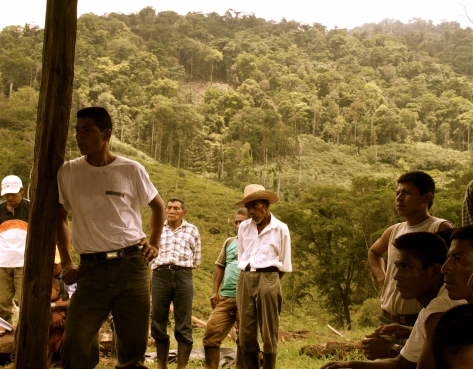 The original village of Lote 8, constructed in the mid 1950s, was situated upon an undulating ridge, soft enough to envision a town of sorts, though now we find small abandoned roads overgrown with grasses and flowers, a fire-scarred tree, and holes left by company geologists. We traveled for an hour on foot down a well-marked path along the contours of the steep, densely forested mountainside to the new village site. It was cool beneath the trees; water flowed through every depression. Tropical birds abound: creepers and thrushes, and wrens buzzing through the undergrowth. We reached the center of the newly constructed village by late morning: a flat basin with cardamom bushes near the edge of the forest, encircling the village.
The original village of Lote 8, constructed in the mid 1950s, was situated upon an undulating ridge, soft enough to envision a town of sorts, though now we find small abandoned roads overgrown with grasses and flowers, a fire-scarred tree, and holes left by company geologists. We traveled for an hour on foot down a well-marked path along the contours of the steep, densely forested mountainside to the new village site. It was cool beneath the trees; water flowed through every depression. Tropical birds abound: creepers and thrushes, and wrens buzzing through the undergrowth. We reached the center of the newly constructed village by late morning: a flat basin with cardamom bushes near the edge of the forest, encircling the village.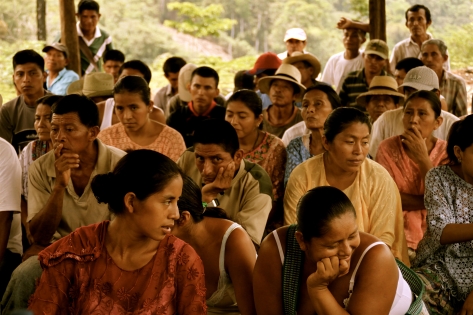 The people were awaiting our arrival, seated in rows of benches, facing west. Perhaps 60 men, women, children and infants, plus dogs seeking refuge from the unrelenting heat—all quietly sitting. The meeting place was an open-air hut with a tin roof, perched on a small knoll that afforded views in all directions. Our group scattered towards the front, some of us on benches, others in the front at a long table facing the crowd. After brief introductions, a bit of clapping and tense smiles, they began to tell us what happened.
The people were awaiting our arrival, seated in rows of benches, facing west. Perhaps 60 men, women, children and infants, plus dogs seeking refuge from the unrelenting heat—all quietly sitting. The meeting place was an open-air hut with a tin roof, perched on a small knoll that afforded views in all directions. Our group scattered towards the front, some of us on benches, others in the front at a long table facing the crowd. After brief introductions, a bit of clapping and tense smiles, they began to tell us what happened.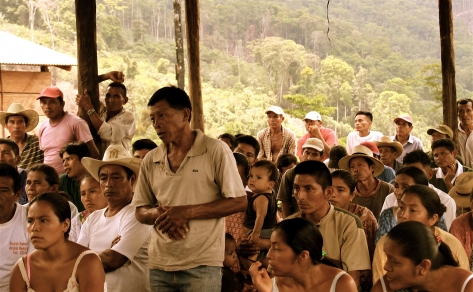 One man, Raul, did most of the talking in his native Qeqchi, which was translated into Spanish by our liaison, and then into English by our guide. Raul’s son, about twenty years old, translated for his father into Spanish. Clear and passionate, Raul's son spoke as if the words were his own. Others added details from time to time, but most fell silent and listened, as we did, to their history. Occasionally we would meet eyes, and smile, nod our heads. The story was tragic. They spoke of ancient ties to this land. The land, their mother, their bearer of corn and culture; they would defend her at all costs. Denied their "own" land (under Western standards of ownership) they were renters, sharecroppers in a way, living on a large finca (farm) whose owner eventually sold the estate to EXMIBAL. Leaders from their community were assassinated for demanding their rights to the land. Negotiations with the companies were always sketchy; officials did not want to provide full documentation of rent payments, which were paid in full for more than 40 years. Sometimes it appeared that the community might win, that they could buy the land outright—a small corner of tremendously rugged terrain. But 2004 was a bad year for all Maya-Qeqchi communities surrounding Izabal. There might be a market for nickel after all, stated revised predictions, graphs and spreadsheets. Soon enough, Skye Resources Incorporated said the global demand would equal the investment needed to reopen the plant in El Estor. On January 9, 2007, hundreds of police, military, and company guards arrived at Lote 8 after burning down a nearby village “They gave us five minutes to leave,” Raul told us, “and 300 Quetzales [equal to USD$37] to take down our own homes.”
One man, Raul, did most of the talking in his native Qeqchi, which was translated into Spanish by our liaison, and then into English by our guide. Raul’s son, about twenty years old, translated for his father into Spanish. Clear and passionate, Raul's son spoke as if the words were his own. Others added details from time to time, but most fell silent and listened, as we did, to their history. Occasionally we would meet eyes, and smile, nod our heads. The story was tragic. They spoke of ancient ties to this land. The land, their mother, their bearer of corn and culture; they would defend her at all costs. Denied their "own" land (under Western standards of ownership) they were renters, sharecroppers in a way, living on a large finca (farm) whose owner eventually sold the estate to EXMIBAL. Leaders from their community were assassinated for demanding their rights to the land. Negotiations with the companies were always sketchy; officials did not want to provide full documentation of rent payments, which were paid in full for more than 40 years. Sometimes it appeared that the community might win, that they could buy the land outright—a small corner of tremendously rugged terrain. But 2004 was a bad year for all Maya-Qeqchi communities surrounding Izabal. There might be a market for nickel after all, stated revised predictions, graphs and spreadsheets. Soon enough, Skye Resources Incorporated said the global demand would equal the investment needed to reopen the plant in El Estor. On January 9, 2007, hundreds of police, military, and company guards arrived at Lote 8 after burning down a nearby village “They gave us five minutes to leave,” Raul told us, “and 300 Quetzales [equal to USD$37] to take down our own homes.” 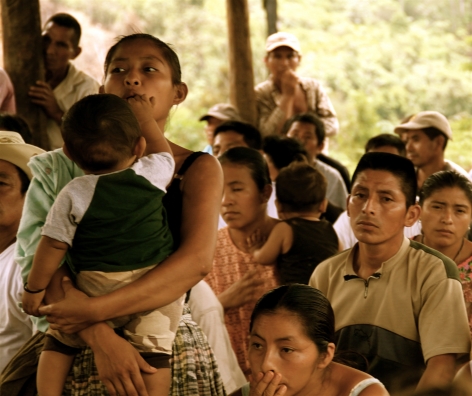 Residents rejected the offer, so the police and guards fired tear gas and bullets at them, forcing them out of the village into the surrounding woods. The company took their possessions, their food and clothing, and burned down all 100 homes. “We watched from above, them burning our things. Some of our homes wouldn’t burn because of the rain, so they used gasoline.” Under the forest canopy, they endured the storm. With nowhere to go, they returned and built inprovised shelters—plastic, bamboo, wooden posts—atop the burnt foundations. “Many days of cold and wet. Terrible days...” Just over a week later the soldiers and private security forces returned. Company helicopters had been seen in previous days as villagers gathered wood for their shelters, fished and hunted. “We knew they were coming, so many of us were not around, we had just basic huts rebuilt.” At this point in his story, over an hour in, Raul rests his voice and hands, looking toward the ground, out to the fields of cardamom, dull green. Attention draws towards the front row of mothers and children. “And this was when some of the women...” he continues, “They were violated... And it is time that their stories are heard.”
Residents rejected the offer, so the police and guards fired tear gas and bullets at them, forcing them out of the village into the surrounding woods. The company took their possessions, their food and clothing, and burned down all 100 homes. “We watched from above, them burning our things. Some of our homes wouldn’t burn because of the rain, so they used gasoline.” Under the forest canopy, they endured the storm. With nowhere to go, they returned and built inprovised shelters—plastic, bamboo, wooden posts—atop the burnt foundations. “Many days of cold and wet. Terrible days...” Just over a week later the soldiers and private security forces returned. Company helicopters had been seen in previous days as villagers gathered wood for their shelters, fished and hunted. “We knew they were coming, so many of us were not around, we had just basic huts rebuilt.” At this point in his story, over an hour in, Raul rests his voice and hands, looking toward the ground, out to the fields of cardamom, dull green. Attention draws towards the front row of mothers and children. “And this was when some of the women...” he continues, “They were violated... And it is time that their stories are heard.”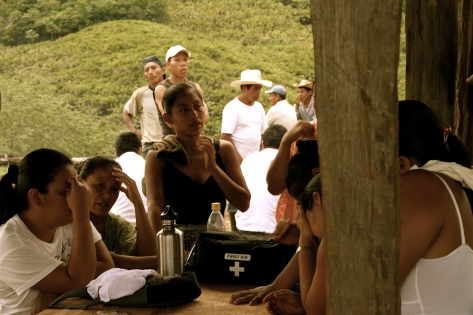 After a short shuffling, a short confusion, the crowd of mostly men leave the hut to the field, standing and mulling about, cutting grass with their machetes. The women move forward, slowly. “I’m scared,” says the first woman. Through tears, the five women recount their stories in Qeqchi to our liaison and translator. They told of gang rapes by the soldiers, police and private security hired by then-Skye Resources. Twelve men. “Where is your husband, they asked me. I told them I didn’t know... I lost my [unborn] baby. I swear to God this is true, what I say,” said one woman, in tears.
After a short shuffling, a short confusion, the crowd of mostly men leave the hut to the field, standing and mulling about, cutting grass with their machetes. The women move forward, slowly. “I’m scared,” says the first woman. Through tears, the five women recount their stories in Qeqchi to our liaison and translator. They told of gang rapes by the soldiers, police and private security hired by then-Skye Resources. Twelve men. “Where is your husband, they asked me. I told them I didn’t know... I lost my [unborn] baby. I swear to God this is true, what I say,” said one woman, in tears.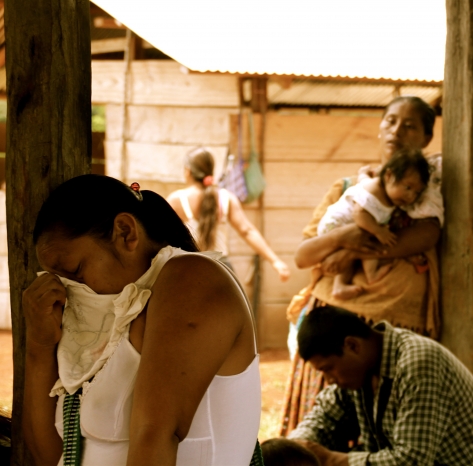 Another, raped by eight men, one man after another. She was also pregnant before the rape. “In one sense,” she tells us, “we allowed ourselves to be raped...to save our husbands, our families.” These aren’t stories from the past, or from the armed conflict, from the scorched earth campaign of the early 1980s. These events took place 14 years after the signing of the Peace Accords. More than a decade after the Truth Commission. This was the second time these women spoke of their experiences, three years after the fact. They tell us of many problems between them and their husbands, but things are getting better. They walk around the table to hug us and look us in the eyes, one by one, and they thank us for listening.
Another, raped by eight men, one man after another. She was also pregnant before the rape. “In one sense,” she tells us, “we allowed ourselves to be raped...to save our husbands, our families.” These aren’t stories from the past, or from the armed conflict, from the scorched earth campaign of the early 1980s. These events took place 14 years after the signing of the Peace Accords. More than a decade after the Truth Commission. This was the second time these women spoke of their experiences, three years after the fact. They tell us of many problems between them and their husbands, but things are getting better. They walk around the table to hug us and look us in the eyes, one by one, and they thank us for listening.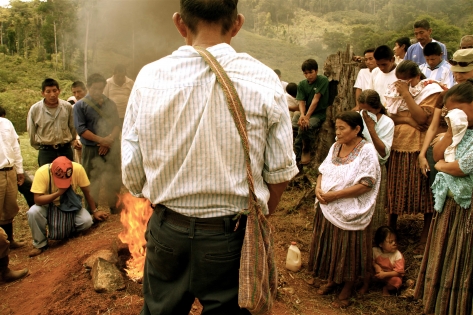 Following their testimonies, we are invited to a ceremony adjacent to the community structure, where a Maya priest is lighting candles and incense, preparing. At once everyone is praying aloud, in Spanish, in Qeqchi. A dozen minutes pass, maybe more. Men are weeping, hands over their faces, asking how things could be as they are. Fifty voices seep into the forest, lie upon their land. Clouds finally shade the sun. We are brought plates of food after the dying of the fire. They are proud to feed us, to share with us their wealth. Some of the women continue to cry, in their eyes a vacancy I cannot forget. “Why do they treat us like animals?” ask the women. “Like things they don’t know? Our women and children have suffered, you heard. This is good land here, and we will not leave. Please denounce this. Please take this to the President of Canada. We demand that your leaders get this company out of here.”
Following their testimonies, we are invited to a ceremony adjacent to the community structure, where a Maya priest is lighting candles and incense, preparing. At once everyone is praying aloud, in Spanish, in Qeqchi. A dozen minutes pass, maybe more. Men are weeping, hands over their faces, asking how things could be as they are. Fifty voices seep into the forest, lie upon their land. Clouds finally shade the sun. We are brought plates of food after the dying of the fire. They are proud to feed us, to share with us their wealth. Some of the women continue to cry, in their eyes a vacancy I cannot forget. “Why do they treat us like animals?” ask the women. “Like things they don’t know? Our women and children have suffered, you heard. This is good land here, and we will not leave. Please denounce this. Please take this to the President of Canada. We demand that your leaders get this company out of here.”Nathan Einbinder is a graduate student in the field of geography. Much of his work focuses on the impacts of development on Indigenous and marginalized people, particularly in Central America.
Related articles:
By the same author:
Comments
Archived Site
The Dominion is a monthly paper published by an incipient network of independent journalists in Canada. It aims to provide accurate, critical coverage that is accountable to its readers and the subjects it tackles. Taking its name from Canada's official status as both a colony and a colonial force, the Dominion examines politics, culture and daily life with a view to understanding the exercise of power.
the abuses and rape of women
My heart goes out to these women who have been so violated and their hearts broken! I want them to know their attackers will be punished by the oNe who sees everything they do and did! But there is real freedom and hope! http://stephaniesprayercorner.blogspot.com/